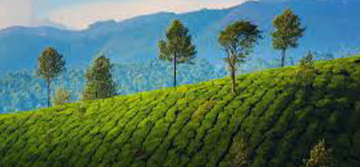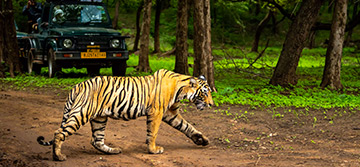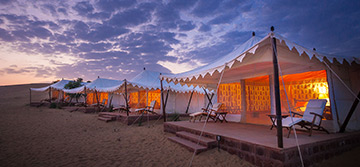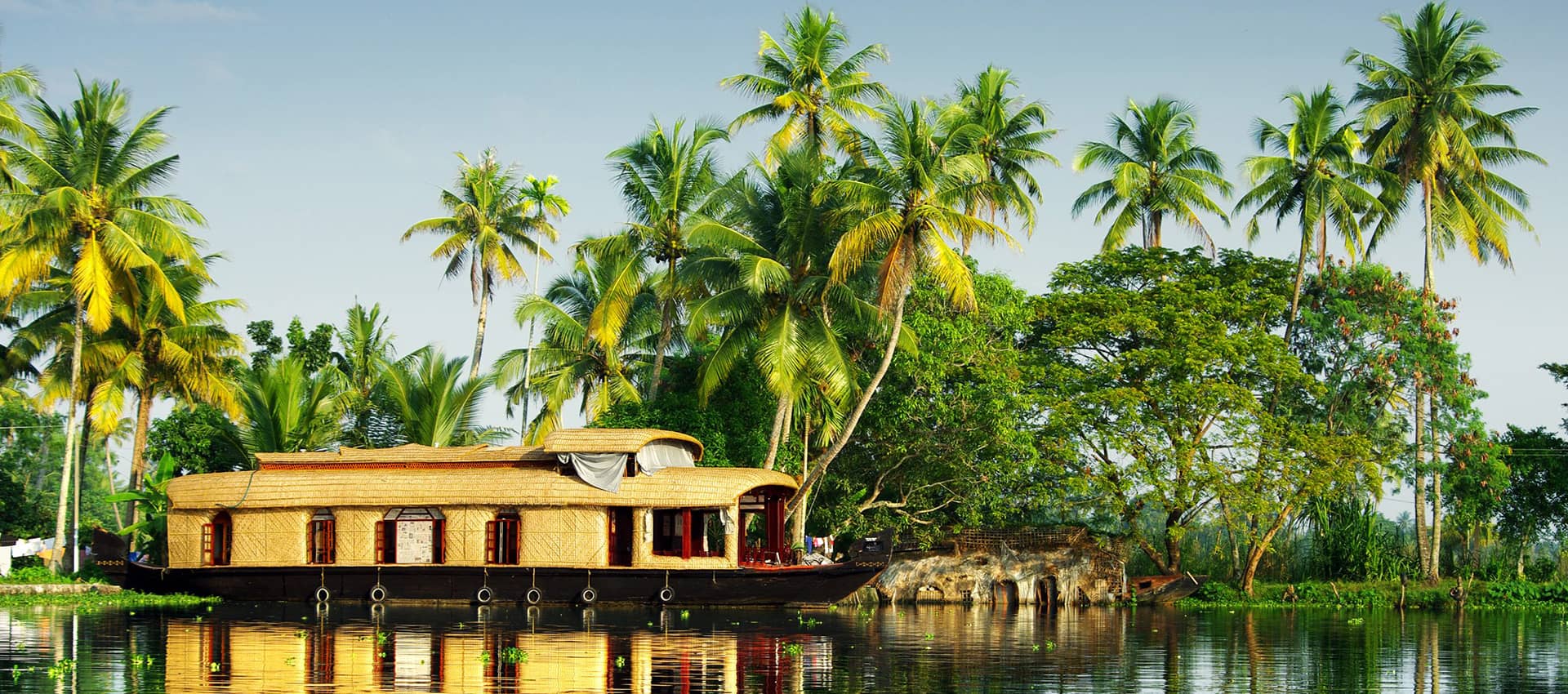Snapshot
Kerala, one of India's most affluent states, is most renowned for its sleepy backwaters, a magnificent network of dreamy lagoons and rivers which have long been a haven for tourists. The backwaters, the setting for Arundhati Roy’s Booker prize-winning novel The God of Small Things’, offer a true experience of India’s enchanting natural landscape and rural life. Kochi (Cochin) is the main centre in this alluring region and the historic Fort area enjoys a picturesque setting where Kerala’s tranquil backwaters meet the shimmering waters of the Arabian Sea. The busy coastal towns in the south west offer traditional sun and sand holidays, whereas further north on the Malabar coast the beautiful coastal landscapes and cultural traditions are more untouched by development and have a distinct flavour. Inland offers many treats as well. Munnar, the major centre of Kerala’s tea-growing hills, is a spectacular mountainous area offering fertile valleys studded with numerous lakes and mountain streams and a host of outdoor pursuits. Wayanad, on the edge of the Western Ghats, is the quietest part of the state and offers untouched wilderness and exotic wildlife. The Keralan climate is similar to western Sri Lanka: the wettest season is May to July with another monsoon in October and November.
Weather
Kerala has a similar sub-tropical climate to the west coast of Sri Lanka. The best time to visit is between late November and mid-March when you can expect lots of blue skies and modest humidity, but this is not the only option. From mid-March onwards, humidity builds as the monsoon begins to build up, but the weather is still predominantly dry. From May, things are less appealing: the early part of the month generally mixes intense heat with heavy showers then, normally, in late May the monsoon begins for real. Expect June and July to be wet. The shoulder season, in August and September, offers improving weather (although there is still some rain about) and lower prices than peak season. Then the north-east monsoon – less disruptive than its predecessor – again brings rain in October and much of November. Munnar, in the hill country is cooler: 20-35C at the hottest times of year, 10C-20C in peak holiday season, with its spectacular waterfalls losing intensity from January to May.
Getting There
Kerala, in India's south west covers about 580 kms of coastline and, at its broadest point, spreads only 130 kms inland into the mountains of the Western Ghats. There are no direct flights to Kerala from Europe but Kochi (Cochin),now one of the busiest airports in India, connects to the major Indian hubs as well as Sri Lanka, the Middle East and Far East. Trivandrum (which now goes under the virtually unmanageable name of Thiruvananthapurum) also offers good India links. The backwaters reach 900 kms - a network of lagoons, lakes, canals, estuaries and 41 rivers – are at their most expansive at Vembanad Lake which extends 75 kms from Kollam in the South to Kochi in the North. Kerala is perfectly positioned for combination holidays with the Indian states of Karnataka and Tamil Nadu, Sri Lanka and The Maldives.
Highlights
- A languid trip down Kerala's backwaters
- The historic centre of Fort Kochi
- The sun-kissed beaches in Kerala's south west
- White sands and unchanging lagoons of northern Kerala
- Expert Ayurveda or Spa treatment
- Nature & Jungle Walks, Bamboo Rafting at Periyar National Park
- Munnar's refreshing mountain scenery
- Traditional festivals and Kathakali dance
- The rock-themed adventure park at Jatayu Earth Centre
Alappuzha:
The Nehru Trophy Boat Race is amongst the main snake boat races in Kerala. It is held on the second Saturday of August every year on Punnamada Lake and draws in a massive crowd as 100 ft long boats compete against each other to the tune of old boat songs. You can watch a video here.
Backwaters:
An exclusive private Village Backwater Cruise in a Country Boat on Kerala’s peaceful backwaters is one of India’s most delightful experiences. Kerala’s houseboats have now become a popular accommodation option.
Chinnar Wildlife Sanctuary:
Situated on the Tamil Nadu border, the Chinnar Wildlife Sanctuary is inhabited by most of the Southern Indian wild animals including wild elephants, the grizzled giant squirrel, champal squirrel and sambar deer.
Eravikulam National Park:
Situated 15 kms from Munnar, the Eravikulam National Park consists of dense forests and boulder-strewn grasslands and engulfs the spectacular Anamudi Peak, the highest in the Western Ghats of South India. Home to the largest population of the Nilgiri Thar, a friendly mountain goat, which shares the park with the elephant, lion-tailed macaque, tiger, leopard, nilgiri langur, malabar giant squirrel, sambar and the barking deer.
Ettumanoor Murals:
Found in the Siva temple near Kottayam. The walls of the sanctum are painted with scenes from the epics.
Jatayu Earth Center:
The world’s largest bird sculpture, inspired by the mythical bird from the Indian epic Ramayana – Jatayu - is the centrepiece of a rock theme park for adventure enthusiasts at Chadayamangalam, 35kms west of Kollam. Legend states that Jatayu tried to save Sita (wife of Lord Rama) when Ravana, a demon king, was abducting her in his airborne chariot. Jatayu, fighting courageously, fell on the rocks and was grievously injured – a story told in a virtual reality presentation. Jatayu claims to be the largest adventure park within a natural terrain. Paintball, ropeway valley crossing, bouldering, zip line, trekking, archery, rappelling, jumaring and wall climbing are among many activities.
Kannur (Cannanmore):
Kannur, 92 kms north of Kozhikode on the coastal route to Goa, is an ancient port. Secluded beaches exist along the coast between Kannur and Kozhikode, but the main reason for visiting this clifftop town is to experience the ancient spirit-possession ritual of Theyyattam (see below).
Kathakali dance:
A live performance of Kathakali is most common in Thrissur (see below). Traditional performances take place outside a temple where elaborately dressed actors play out otherworldly plots on a lamplight stage. Combines facets of ballet, opera, masque and pantomime.
Kalaripayattu:
The only ancient form of martial arts still in existence. Kalaripayattu is a unique art of physical culture and self-defence believed to be 5,000 years old.
Kochi:
Fort Kochi has some of best-preserved examples of early colonial buildings. The Jewish Synagogue, 400 years old, is situated nearby the Mattancherry Palace in Fort Cochin. Mattancherry Palace, built by the Portuguese in 1557, has interior walls adorned with high-quality murals. The church of St Francis, the oldest European church in India, stands on the corner of an English-style village green and contains artefacts and engravings which document a turbulent history. South of the church is the late 20C Santa Cruz Cathedral.
Kovalam:
Kerala’s most popular beach resort, Kovalam attracts growing numbers of travellers on budget or package holidays. The town is only 6 kms south of Trivandrum’s International Airport. Nightlife remains sedate, based around tranquil beach restaurants and cafes.
Kozhikode (Calicut):
This coastal city, nearly 200 kms north of Kochi, was formerly one of Asia’s most prosperous trading capitals. Nowadays, Kozhikode is a congested town. Visit the ancient shipyard of Beypore situated 11 kms south of Kozhikode where large Arabian wooden dhows are still handmade in traditional fashion.
Kumarakom Bird Sanctuary:
The Vembanad Lake is the most extensive body of water in Kerela's backwaters with six rivers draining into it from the Western Ghats. The silts deposited by these rivers have created several islands of ecological importance, especially in terms of birdlife. Kumarakom Bird Sanctuary hosts large populations of herons and cormorants. Best visited between November and March, but poorly maintained in places and lacking guides and infrastructure.
Mararikulam:
The small fishing village of Mararikulam is only 14 kilometres from Alleppey, and just over an hour south of Cochin, and is the perfect place to relax on the beach at the end of a tour of Kerala or after a journey aboard a traditional houseboat. About two hours from Kochi and only 40 minutes from the backwaters area of Alleppey.
Munnar:
This hill station was once the summer resort of the British colonialists. Sprawling tea plantations, gushing waterfalls, untouched wilderness with exotic flora and fauna, makes this escapist destination perfect for trekking, mountain climbing, bird watching, boating, trout fishing, and cycling. Munnar is surrounded by rows of jagged peaks, including Anamudi, a source of debate among scholars about whether it is the highest peak in south India.
Neyyar Wildlife Sanctuary and Agastya Hills:
Wildlife includes tiger, leopard, elephants, lion-tailed macaques, gaur, sloth bear, nilgiri thar, jungle cat and sambur deer. You can hire a speedboat to visit a crocodile farm and also see more of the forest.
Padmanabhapuram
Padmanabhapuram is a well-maintained wooden palace, erected in the 16C, with striking murals, floral carvings and black granite floor. This ancient palace with mesmerizing architecture is close to the Kerala – Tamil Nadu border near Kumaracoil.
Parambikulam:
Quieter than Periyar and possessing some great budget accommodation. Spot elephant and bison, among others, in this well-run wildlife reserve.
Pallakad:
Palakkad, a vast expanse of verdant plains interspersed with hills, rivers, mountain streams and forests, is the gateway to Kerala from the north through the Plakkad Gap. Silent Valley National Park, a tiny rainforest, is home to numerous species of birds, butterflies and animals including the rare lion-tailed macaque. Palakkad Fort is one of the best-preserved forts in Kerala.
Periyar Wildlife Sanctuary:
The wildlife sanctuary – just across the border in Tamil Nadu - is one of the most popular in India, attracting 300,000 visitors per year. The park was first declared a forest reserve by the Maharaja of Travencore over a century ago. The best time to visit is from September to May when the dry season draws animals out of the forest to the lake. Daily boat trips are conducted on Periyar Lake. You can also go bamboo rafting and since these rafts are paddled, there is a great chance of seeing wild animals, including elephants, bathing in the lake. Bison, sambar, barking deer and wild boar can also be seen, along with numerous birds and butterflies.
Poovar:
A half-hour drive south of Kovalam and 35kms from Trivandrum Airport, Poovar Island is surrounded by a lagoon, the Poovar River and the Arabian Sea. The backwaters shelter a collection of luxury hideaways accessed via a 15-minute boat ride.
Thekkady:
Thekkady is a town that lies to the north of Periyar Lake. As well as trekking and nature walks, a boat ride on the lake and safari in the Periyar Wildlife Sanctuary are popular activities. Boat races here match Alappuzha for popularity. The sleepy town of Chellarkovil overlooks the green side of Thekkady with a breathtaking view of the plains and waterfalls. Scenic hill stations such as Ramakkalmedu and Panchalimedu are within driving distance.
Thattekad Bird Sanctuary:
A two-hour drive from Kochi takes you to the Thattekad Bird Sanctuary, on the northern bank of the Periyar River. Once the finest bird habitat in India, this shrunken 25 sq km park still boasts 270 species, including the rare spot-bellied eagle owl, grey-headed bulbul, rusty-tailed flycatcher, and mottled wood owl.
Theyyattam:
These dramatic spirit-possession ceremonies have over 450 manifestations with each having distinctly different costumes, make-up and music. Traditional Theyyam performers invoke the temple deity with their frenzied dancing and throbbing temple music in the courtyards of village temples. Theyyattam is the oldest ritual art form of Kerala and is practiced during the winter months throughout the temples of Kannur.
Thrissur:
Thrissur (Trichur),two hours north of Kochi, lays claim to being the cultural capital of Kerala. The town centres around the hillside Vaddukanatha Temple, the largest temple complex in the state. The annual Pooram Festival, the largest and most extravagant festival in Kerala, takes place in April/May and includes scores of elephants, drums and fireworks. Thrissur is also a good place to purchase traditional Keralan handicrafts. Cheraman Juma Masjid is the oldest mosque in India. Guruvayoor, the most important Krishna shrine in the state, hosts 24 festivals a year – the most important festival is Ekadashi, held in Nov/Dec, which attracts a huge number of pilgrims, all attired in white. The temple is also famous for elephant races and processions, especially in Feb/Mar. Lourdes Cathedral is a Syrian-Catholic church where you can climb 350 steps up the tower for spectacular views.
Trivandrum (Thiruvananthapuram):
Kerala’s pleasantly laid-back capital city is set on seven low hills in the deep south and is close to Kovalam’s golden beaches. Interesting spots include: the Sri Padmanabha Swamy Temple (the interior is off limits to non-Hindus),the Kuthiramalika Palace Museum, the Sri Chitra Art Gallery and the Napier Museum.
Varkala:
Varkala, boasting white-sanded beaches backed by dramatic red cliffs, has steadily grown in popularity in recent years. A wide and long beach is superb during the season from October to mid-March and relatively peaceful in comparison to Kovalam. Varkala is also an important Hindu pilgrimage area. Go down to the Papanasam Beach early morning and observe the Shraadh Pujas (sacred devotions). Interesting places to visit include the 2,000 year old shrine of Lord Vishnu - the Janardhanaswamy Temple.
Valiyaparamba:
The northern backwaters offer a less touristy alternative to the more famous ones further south.
Waterfalls:
Many of the finest are to be found around Munnar (see above) but Athirappally, two hours north-east from Kochi, is arguably the most spectacular.
Wayanad Wildlife Sanctuary:
This sprawling wildlife sanctuary lies in the far north of Kerala, approximately 70 kms from Kozhikode. Poor roads made progress slow so allow plenty of time. Muthanga wildlife sanctuary covers the southern part of the Wayanad reserve and is noted for elephants, deer, bear, and wild boar. The Tholpetty wildlife sanctuary covers the northern section and is home to wild elephants, bison, sambar, macaques and langurs. Trekking or jeep safaris are possible.
Kerala came to prominence as a result of trade with the East. Ships from ancient Sumeria and Rome, China, Arabia, Persia, East Africa were attracted to the shores of the Malabar Coast in search of aromatic spices, precious gems, gold and silk. Trade links were first fought over by the Cheras and the neighbouring Cholas, the incursions of the latter being repelled by the end of the 11C. The Europeans, led by the Portuguese general Vasco da Gama, arrived in India in 1498, followed by the Dutch and the British. All brought with them new ideas, lifestyles, religions and cuisine which remain a part of Kerala's intriguing heritage. The majority of the population is Hindu but up to a quarter of Kerala's inhabitants are Christian and there is also a sizeable Muslim population.
Food and drink in Kerala
Kerala is known as the "Land of Spices" and has traded spices with Europe and other ancient civilisations for centuries. It is particularly strong for vegetarian dishes, although its mix of religions and cultures means that it has impressive variety and also offers an abundance of fish, poultry and red meat, often accompanied by rice. A long coastline means an abundance of seafood like fish, prawns, mussels, lobsters, and crabs. Sadya, famously, is a vegetarian feast that can extend to up to 28 dishes and is traditionally served on a plantain leaf. Mappila Cuisine – or Muslin cuisine – is characterised by widespread use of black pepper, cardamon and clove. Christian influence can be seen in a variety of fish and meat stews. Much more information here.
India Itineraries

Sri Lanka and Kerala Tour
15 nights / 16 days
Sigiriya, Kandy, Ella, Kochi, Kumarakom
Enjoy the best that Sri Lanka can offer before hopping across to Kerala to experience the sights and sounds of Kochi, Alappuzha, and Kumarakom.
Starting fromUSD 3497per person

Classic Rajasthan
13 nights / 14 days
Delhi, Agra, Jaipur, Bikaner, Deshnok, Jaisalmer, Jodhpur, Udaipur
Rajasthan’s fantastical palaces, led by the incomparable Taj Mahal, and huge forts stand as living monuments in an awe-inspiring desert landscape

Explore Kerala
12 nights / 13 days
Kochi, Munnar, Periyar, Alappuzha, Kovalam
Red Dot's Explore Kerala itinerary takes you on a classic route through Kerala's diverse landscapes, from Fort Kochi and the serene backwaters to its south-west beaches.
Starting fromUSD 2398per person

Kerala & Maldives Combo
14 nights / 15 days
Kochi, Munnar, Thekkady, Backwaters, Kerala, Maldives
Our Kerala & Maldives Combo gets you in the mood for an enchanting beach stay at a top Maldives resort with an energetic opener in the south of India.

Green Rajasthan
11 nights / 12 days
Delhi, Agra, Jaipur, Shahpura Bagh, Udaipur
Green Rajasthan is a special 12-day trip designed for those who prefer to forego the most arid parts of India’s most popular tourist destination.

Luxury Rajasthan Safari
10 nights / 11 days
Delhi, Agra, Ranthambhore, Jaipur, Udaipur
This luxury tour around the highlights of Rajasthan mixes stunning desert landscapes with a visit to Ranthambore national park - and Rajasthan’s finest wildlife safari

Luxury Rajasthan with Desert Camp
9 nights / 10 days
Delhi, Manvar, Jodhpur, Udaipur, Jaipur, Agra
Sample the highlights of Rajasthan, India’s awe-inspiring desert state, on a luxury tour which also offers the chance also to camp under the desert stars.

























